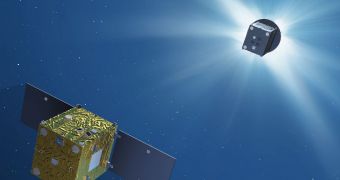Officials at ESA say that they have just finished work on the first simulator that will make it easier for space agencies to launch multiple satellites that fly in formation.
Having this ability could mean advancements in a wide variety of research fields, ranging from gravity measurements to studying the Sun and its atmosphere.
But flying two or more satellites in formation is a tremendously complex and difficult task, one that requires the utmost coordination and precision.
The new simulator was designed specifically to answer these needs, by providing a framework for engineering crews to test their ideas before actually building the spacecrafts.
Experts now believe that the first mission to benefit from the new simulator will be Proba-3, which is currently being developed by the European Space Agency.
The mission, which is currently scheduled for take-off in 2014-2015, will feature two components. One will play the role of a sunblock, creating a perpetual eclipse for the second satellite.
As the two fly in formation, the spacecraft that remains in the shadow can conduct studies of the solar atmosphere with delicate instruments, that would otherwise get “blinded” by the powerful light.
The simulator, called the Formation Flying Test Bed, was developed by the same company handling Proba-3's software development efforts. The firm is called Spacebel, and is based in Belgium.
“It is a generic simulator for formation-flying missions, whether they include two spacecraft or as many as five or six,” says Raffaella Franco, who is an expert with the Galileo project.
“Simulations are a computer-intensive business anyway, but trying to emulate more than one spacecraft’s onboard computer and software simply will not run on a single computer, not to mention the rest of the satellite and the associated ground systems and inter-satellite links,” she adds.
“Instead, the Formation Flying Test Bed allows the distribution of software across multiple computers without affecting the user experience,” the official goes on to say.
The development of the Formation Flying Test Bed was overseen by the Software Systems division at ESA, which is based at the ESTEC space research and technology center, in the Netherlands.

 14 DAY TRIAL //
14 DAY TRIAL //